Ecommerce Website Business Plan for Retail Clothing Company
VerifiedAdded on 2021/06/15
|18
|5441
|25
AI Summary
This business plan outlines the strategy for a retail clothing company to establish an ecommerce website. It details the organizational background, emphasizing the value proposition of providing affordable, high-quality clothing with the latest designs. The plan addresses efficiency and profitability, focusing on balancing service quality with cost management. Key features for enhancing the shopper's experience are discussed, including advanced search options, a streamlined checkout process, customer support via chat, and social media integration. The document also covers the system architecture, software applications, payment options, and security considerations necessary for a successful online retail operation. Metrics for evaluating website performance and strategies for improvement are also included.
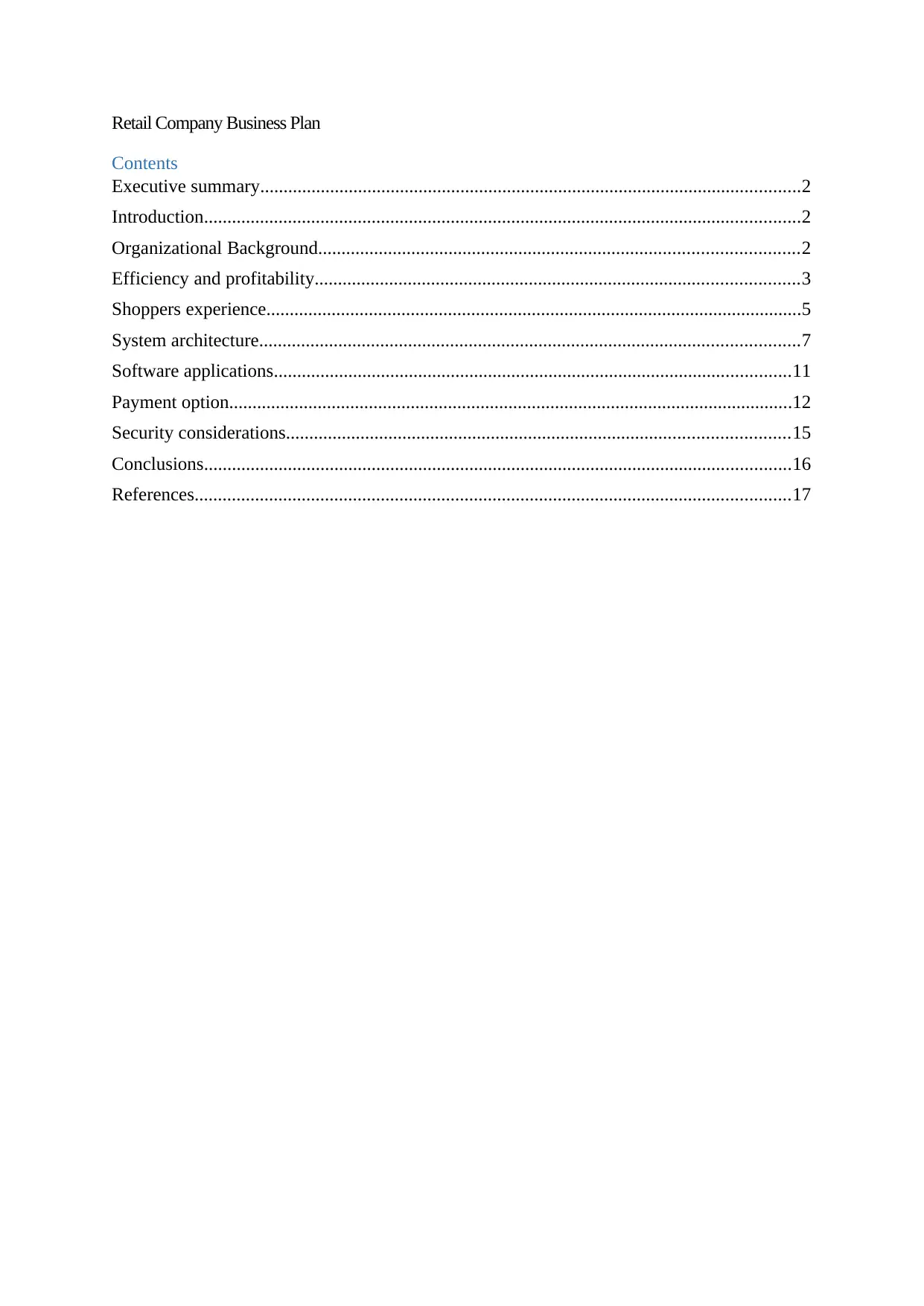
Retail Company Business Plan
Contents
Executive summary....................................................................................................................2
Introduction................................................................................................................................2
Organizational Background.......................................................................................................2
Efficiency and profitability........................................................................................................3
Shoppers experience...................................................................................................................5
System architecture....................................................................................................................7
Software applications...............................................................................................................11
Payment option.........................................................................................................................12
Security considerations............................................................................................................15
Conclusions..............................................................................................................................16
References................................................................................................................................17
Contents
Executive summary....................................................................................................................2
Introduction................................................................................................................................2
Organizational Background.......................................................................................................2
Efficiency and profitability........................................................................................................3
Shoppers experience...................................................................................................................5
System architecture....................................................................................................................7
Software applications...............................................................................................................11
Payment option.........................................................................................................................12
Security considerations............................................................................................................15
Conclusions..............................................................................................................................16
References................................................................................................................................17
Paraphrase This Document
Need a fresh take? Get an instant paraphrase of this document with our AI Paraphraser
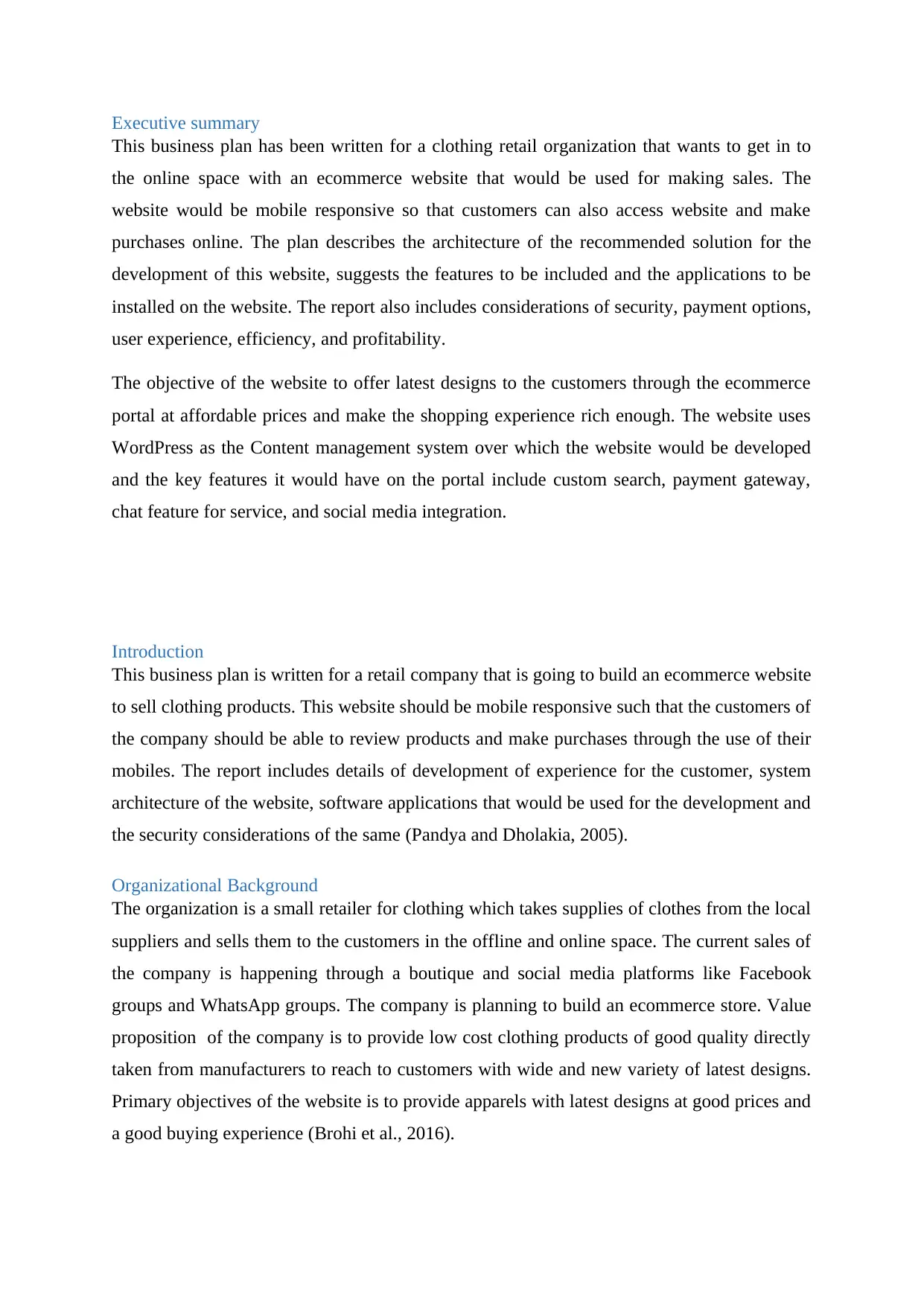
Executive summary
This business plan has been written for a clothing retail organization that wants to get in to
the online space with an ecommerce website that would be used for making sales. The
website would be mobile responsive so that customers can also access website and make
purchases online. The plan describes the architecture of the recommended solution for the
development of this website, suggests the features to be included and the applications to be
installed on the website. The report also includes considerations of security, payment options,
user experience, efficiency, and profitability.
The objective of the website to offer latest designs to the customers through the ecommerce
portal at affordable prices and make the shopping experience rich enough. The website uses
WordPress as the Content management system over which the website would be developed
and the key features it would have on the portal include custom search, payment gateway,
chat feature for service, and social media integration.
Introduction
This business plan is written for a retail company that is going to build an ecommerce website
to sell clothing products. This website should be mobile responsive such that the customers of
the company should be able to review products and make purchases through the use of their
mobiles. The report includes details of development of experience for the customer, system
architecture of the website, software applications that would be used for the development and
the security considerations of the same (Pandya and Dholakia, 2005).
Organizational Background
The organization is a small retailer for clothing which takes supplies of clothes from the local
suppliers and sells them to the customers in the offline and online space. The current sales of
the company is happening through a boutique and social media platforms like Facebook
groups and WhatsApp groups. The company is planning to build an ecommerce store. Value
proposition of the company is to provide low cost clothing products of good quality directly
taken from manufacturers to reach to customers with wide and new variety of latest designs.
Primary objectives of the website is to provide apparels with latest designs at good prices and
a good buying experience (Brohi et al., 2016).
This business plan has been written for a clothing retail organization that wants to get in to
the online space with an ecommerce website that would be used for making sales. The
website would be mobile responsive so that customers can also access website and make
purchases online. The plan describes the architecture of the recommended solution for the
development of this website, suggests the features to be included and the applications to be
installed on the website. The report also includes considerations of security, payment options,
user experience, efficiency, and profitability.
The objective of the website to offer latest designs to the customers through the ecommerce
portal at affordable prices and make the shopping experience rich enough. The website uses
WordPress as the Content management system over which the website would be developed
and the key features it would have on the portal include custom search, payment gateway,
chat feature for service, and social media integration.
Introduction
This business plan is written for a retail company that is going to build an ecommerce website
to sell clothing products. This website should be mobile responsive such that the customers of
the company should be able to review products and make purchases through the use of their
mobiles. The report includes details of development of experience for the customer, system
architecture of the website, software applications that would be used for the development and
the security considerations of the same (Pandya and Dholakia, 2005).
Organizational Background
The organization is a small retailer for clothing which takes supplies of clothes from the local
suppliers and sells them to the customers in the offline and online space. The current sales of
the company is happening through a boutique and social media platforms like Facebook
groups and WhatsApp groups. The company is planning to build an ecommerce store. Value
proposition of the company is to provide low cost clothing products of good quality directly
taken from manufacturers to reach to customers with wide and new variety of latest designs.
Primary objectives of the website is to provide apparels with latest designs at good prices and
a good buying experience (Brohi et al., 2016).
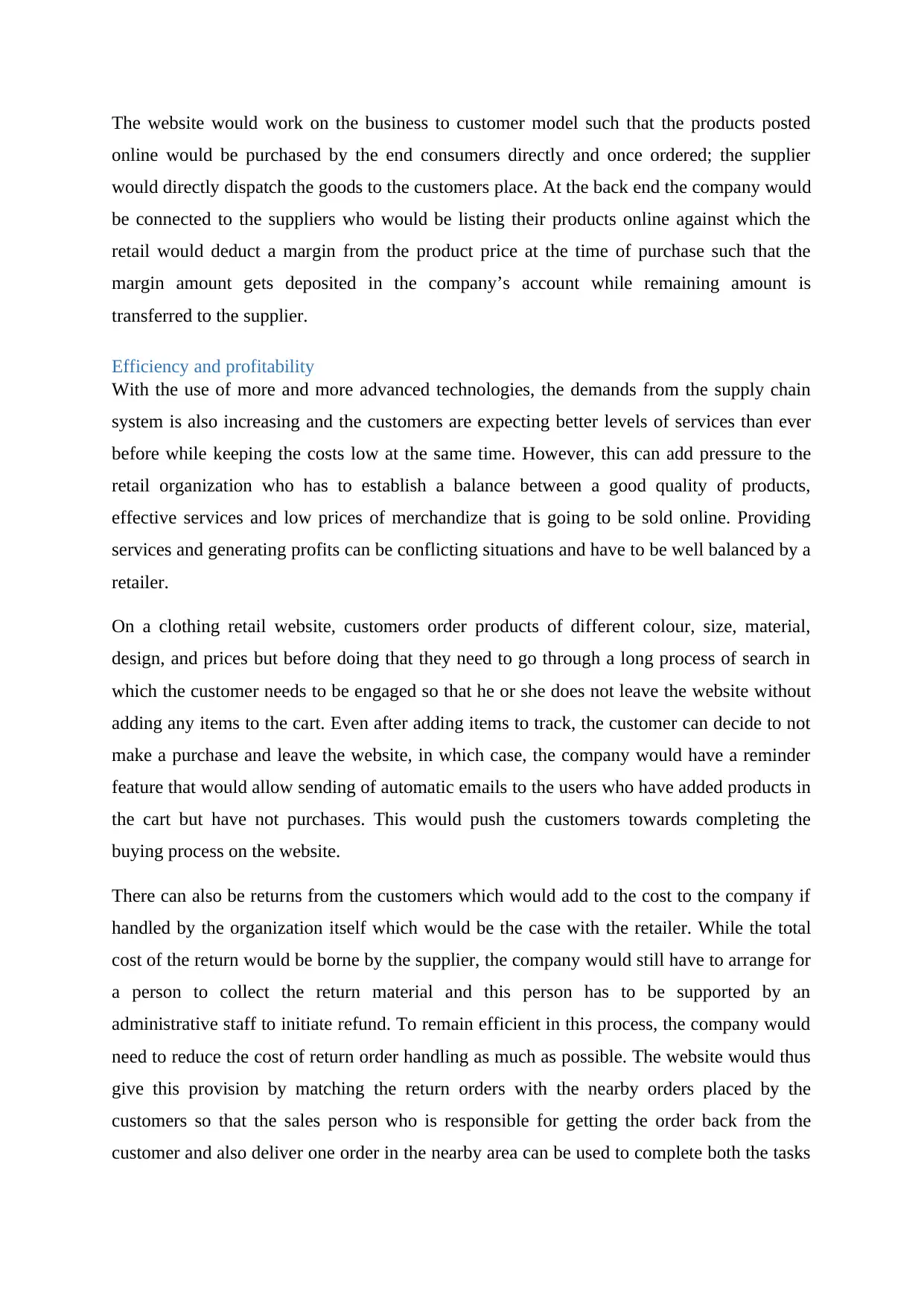
The website would work on the business to customer model such that the products posted
online would be purchased by the end consumers directly and once ordered; the supplier
would directly dispatch the goods to the customers place. At the back end the company would
be connected to the suppliers who would be listing their products online against which the
retail would deduct a margin from the product price at the time of purchase such that the
margin amount gets deposited in the company’s account while remaining amount is
transferred to the supplier.
Efficiency and profitability
With the use of more and more advanced technologies, the demands from the supply chain
system is also increasing and the customers are expecting better levels of services than ever
before while keeping the costs low at the same time. However, this can add pressure to the
retail organization who has to establish a balance between a good quality of products,
effective services and low prices of merchandize that is going to be sold online. Providing
services and generating profits can be conflicting situations and have to be well balanced by a
retailer.
On a clothing retail website, customers order products of different colour, size, material,
design, and prices but before doing that they need to go through a long process of search in
which the customer needs to be engaged so that he or she does not leave the website without
adding any items to the cart. Even after adding items to track, the customer can decide to not
make a purchase and leave the website, in which case, the company would have a reminder
feature that would allow sending of automatic emails to the users who have added products in
the cart but have not purchases. This would push the customers towards completing the
buying process on the website.
There can also be returns from the customers which would add to the cost to the company if
handled by the organization itself which would be the case with the retailer. While the total
cost of the return would be borne by the supplier, the company would still have to arrange for
a person to collect the return material and this person has to be supported by an
administrative staff to initiate refund. To remain efficient in this process, the company would
need to reduce the cost of return order handling as much as possible. The website would thus
give this provision by matching the return orders with the nearby orders placed by the
customers so that the sales person who is responsible for getting the order back from the
customer and also deliver one order in the nearby area can be used to complete both the tasks
online would be purchased by the end consumers directly and once ordered; the supplier
would directly dispatch the goods to the customers place. At the back end the company would
be connected to the suppliers who would be listing their products online against which the
retail would deduct a margin from the product price at the time of purchase such that the
margin amount gets deposited in the company’s account while remaining amount is
transferred to the supplier.
Efficiency and profitability
With the use of more and more advanced technologies, the demands from the supply chain
system is also increasing and the customers are expecting better levels of services than ever
before while keeping the costs low at the same time. However, this can add pressure to the
retail organization who has to establish a balance between a good quality of products,
effective services and low prices of merchandize that is going to be sold online. Providing
services and generating profits can be conflicting situations and have to be well balanced by a
retailer.
On a clothing retail website, customers order products of different colour, size, material,
design, and prices but before doing that they need to go through a long process of search in
which the customer needs to be engaged so that he or she does not leave the website without
adding any items to the cart. Even after adding items to track, the customer can decide to not
make a purchase and leave the website, in which case, the company would have a reminder
feature that would allow sending of automatic emails to the users who have added products in
the cart but have not purchases. This would push the customers towards completing the
buying process on the website.
There can also be returns from the customers which would add to the cost to the company if
handled by the organization itself which would be the case with the retailer. While the total
cost of the return would be borne by the supplier, the company would still have to arrange for
a person to collect the return material and this person has to be supported by an
administrative staff to initiate refund. To remain efficient in this process, the company would
need to reduce the cost of return order handling as much as possible. The website would thus
give this provision by matching the return orders with the nearby orders placed by the
customers so that the sales person who is responsible for getting the order back from the
customer and also deliver one order in the nearby area can be used to complete both the tasks
⊘ This is a preview!⊘
Do you want full access?
Subscribe today to unlock all pages.

Trusted by 1+ million students worldwide
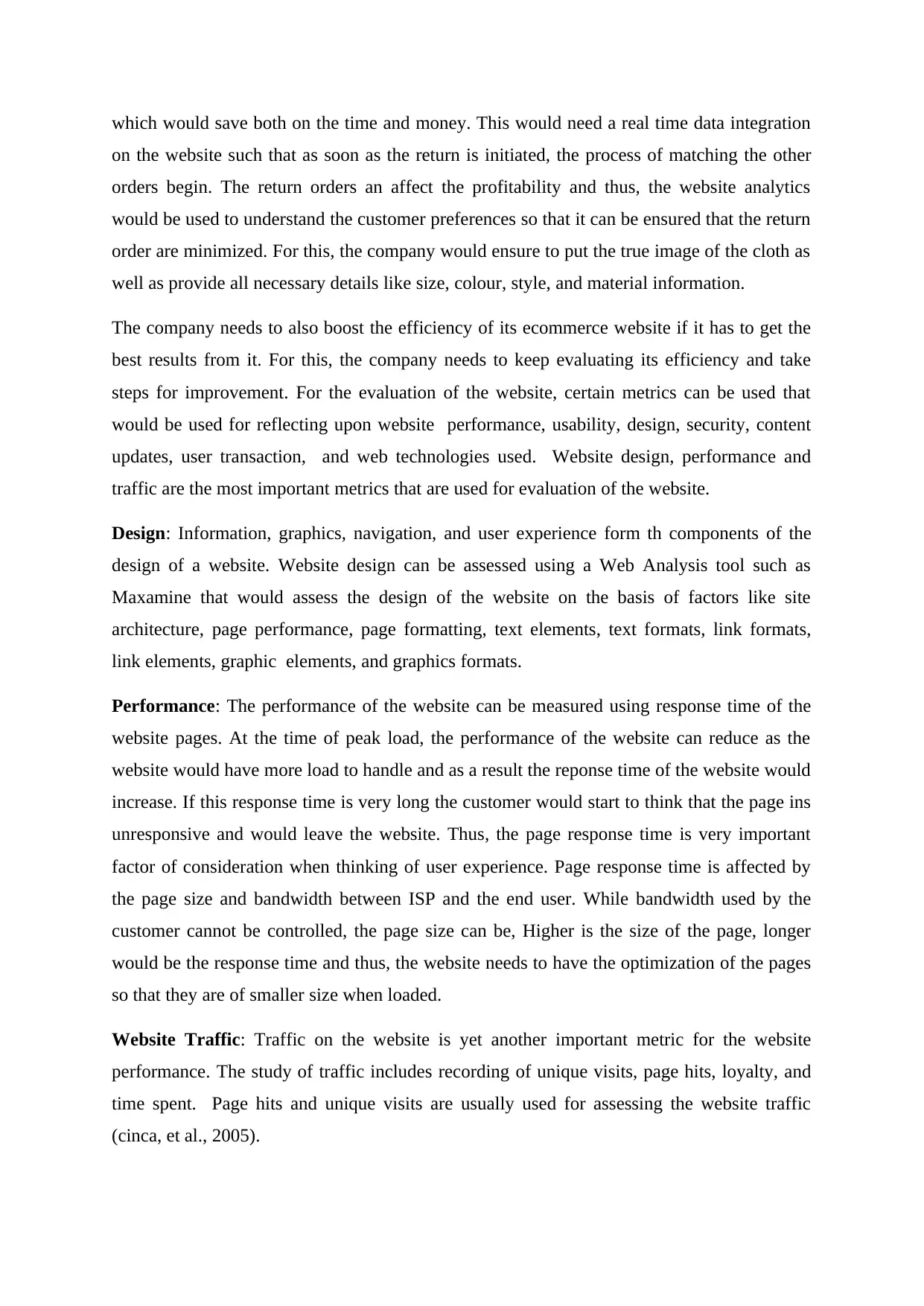
which would save both on the time and money. This would need a real time data integration
on the website such that as soon as the return is initiated, the process of matching the other
orders begin. The return orders an affect the profitability and thus, the website analytics
would be used to understand the customer preferences so that it can be ensured that the return
order are minimized. For this, the company would ensure to put the true image of the cloth as
well as provide all necessary details like size, colour, style, and material information.
The company needs to also boost the efficiency of its ecommerce website if it has to get the
best results from it. For this, the company needs to keep evaluating its efficiency and take
steps for improvement. For the evaluation of the website, certain metrics can be used that
would be used for reflecting upon website performance, usability, design, security, content
updates, user transaction, and web technologies used. Website design, performance and
traffic are the most important metrics that are used for evaluation of the website.
Design: Information, graphics, navigation, and user experience form th components of the
design of a website. Website design can be assessed using a Web Analysis tool such as
Maxamine that would assess the design of the website on the basis of factors like site
architecture, page performance, page formatting, text elements, text formats, link formats,
link elements, graphic elements, and graphics formats.
Performance: The performance of the website can be measured using response time of the
website pages. At the time of peak load, the performance of the website can reduce as the
website would have more load to handle and as a result the reponse time of the website would
increase. If this response time is very long the customer would start to think that the page ins
unresponsive and would leave the website. Thus, the page response time is very important
factor of consideration when thinking of user experience. Page response time is affected by
the page size and bandwidth between ISP and the end user. While bandwidth used by the
customer cannot be controlled, the page size can be, Higher is the size of the page, longer
would be the response time and thus, the website needs to have the optimization of the pages
so that they are of smaller size when loaded.
Website Traffic: Traffic on the website is yet another important metric for the website
performance. The study of traffic includes recording of unique visits, page hits, loyalty, and
time spent. Page hits and unique visits are usually used for assessing the website traffic
(cinca, et al., 2005).
on the website such that as soon as the return is initiated, the process of matching the other
orders begin. The return orders an affect the profitability and thus, the website analytics
would be used to understand the customer preferences so that it can be ensured that the return
order are minimized. For this, the company would ensure to put the true image of the cloth as
well as provide all necessary details like size, colour, style, and material information.
The company needs to also boost the efficiency of its ecommerce website if it has to get the
best results from it. For this, the company needs to keep evaluating its efficiency and take
steps for improvement. For the evaluation of the website, certain metrics can be used that
would be used for reflecting upon website performance, usability, design, security, content
updates, user transaction, and web technologies used. Website design, performance and
traffic are the most important metrics that are used for evaluation of the website.
Design: Information, graphics, navigation, and user experience form th components of the
design of a website. Website design can be assessed using a Web Analysis tool such as
Maxamine that would assess the design of the website on the basis of factors like site
architecture, page performance, page formatting, text elements, text formats, link formats,
link elements, graphic elements, and graphics formats.
Performance: The performance of the website can be measured using response time of the
website pages. At the time of peak load, the performance of the website can reduce as the
website would have more load to handle and as a result the reponse time of the website would
increase. If this response time is very long the customer would start to think that the page ins
unresponsive and would leave the website. Thus, the page response time is very important
factor of consideration when thinking of user experience. Page response time is affected by
the page size and bandwidth between ISP and the end user. While bandwidth used by the
customer cannot be controlled, the page size can be, Higher is the size of the page, longer
would be the response time and thus, the website needs to have the optimization of the pages
so that they are of smaller size when loaded.
Website Traffic: Traffic on the website is yet another important metric for the website
performance. The study of traffic includes recording of unique visits, page hits, loyalty, and
time spent. Page hits and unique visits are usually used for assessing the website traffic
(cinca, et al., 2005).
Paraphrase This Document
Need a fresh take? Get an instant paraphrase of this document with our AI Paraphraser
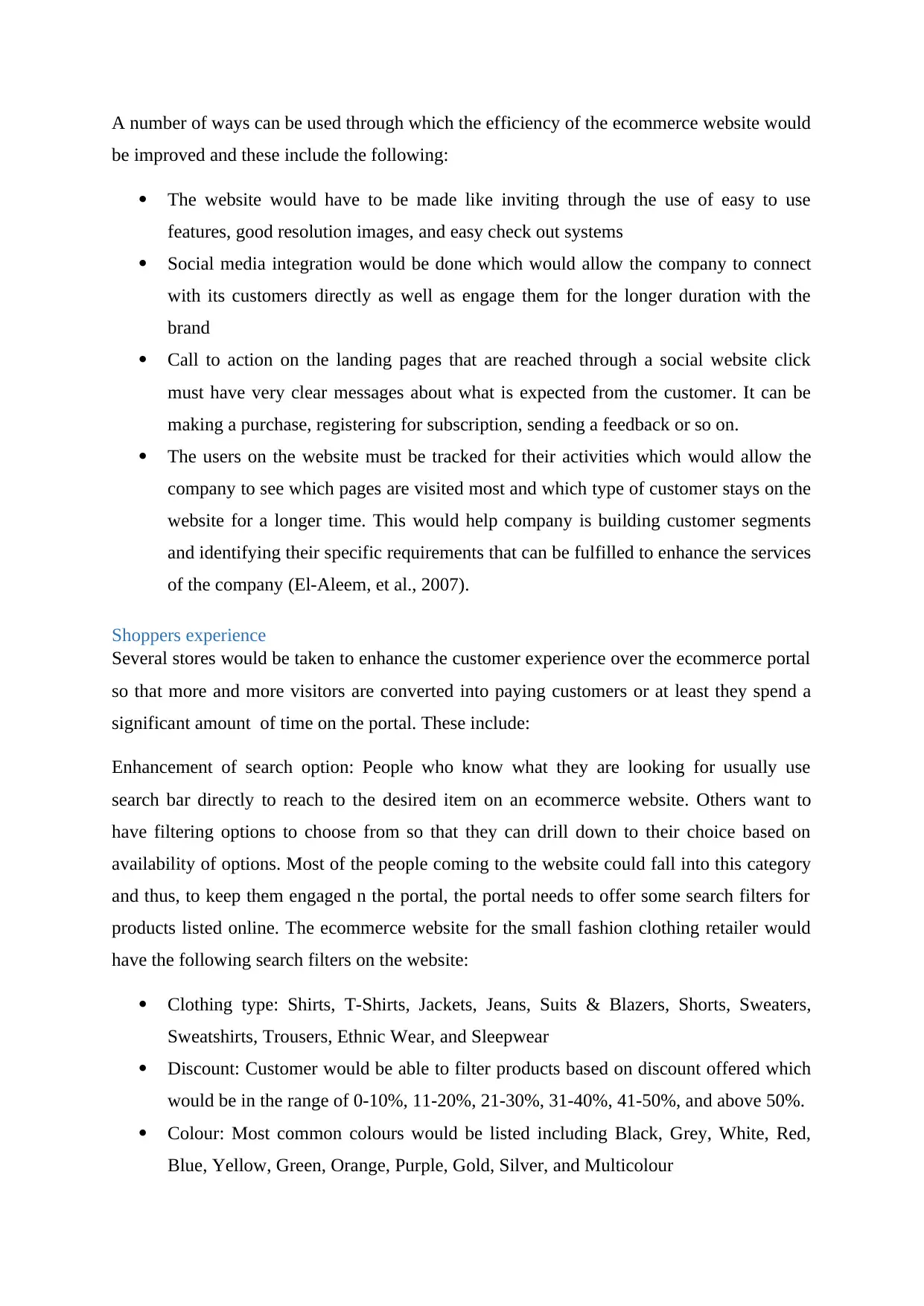
A number of ways can be used through which the efficiency of the ecommerce website would
be improved and these include the following:
The website would have to be made like inviting through the use of easy to use
features, good resolution images, and easy check out systems
Social media integration would be done which would allow the company to connect
with its customers directly as well as engage them for the longer duration with the
brand
Call to action on the landing pages that are reached through a social website click
must have very clear messages about what is expected from the customer. It can be
making a purchase, registering for subscription, sending a feedback or so on.
The users on the website must be tracked for their activities which would allow the
company to see which pages are visited most and which type of customer stays on the
website for a longer time. This would help company is building customer segments
and identifying their specific requirements that can be fulfilled to enhance the services
of the company (El-Aleem, et al., 2007).
Shoppers experience
Several stores would be taken to enhance the customer experience over the ecommerce portal
so that more and more visitors are converted into paying customers or at least they spend a
significant amount of time on the portal. These include:
Enhancement of search option: People who know what they are looking for usually use
search bar directly to reach to the desired item on an ecommerce website. Others want to
have filtering options to choose from so that they can drill down to their choice based on
availability of options. Most of the people coming to the website could fall into this category
and thus, to keep them engaged n the portal, the portal needs to offer some search filters for
products listed online. The ecommerce website for the small fashion clothing retailer would
have the following search filters on the website:
Clothing type: Shirts, T-Shirts, Jackets, Jeans, Suits & Blazers, Shorts, Sweaters,
Sweatshirts, Trousers, Ethnic Wear, and Sleepwear
Discount: Customer would be able to filter products based on discount offered which
would be in the range of 0-10%, 11-20%, 21-30%, 31-40%, 41-50%, and above 50%.
Colour: Most common colours would be listed including Black, Grey, White, Red,
Blue, Yellow, Green, Orange, Purple, Gold, Silver, and Multicolour
be improved and these include the following:
The website would have to be made like inviting through the use of easy to use
features, good resolution images, and easy check out systems
Social media integration would be done which would allow the company to connect
with its customers directly as well as engage them for the longer duration with the
brand
Call to action on the landing pages that are reached through a social website click
must have very clear messages about what is expected from the customer. It can be
making a purchase, registering for subscription, sending a feedback or so on.
The users on the website must be tracked for their activities which would allow the
company to see which pages are visited most and which type of customer stays on the
website for a longer time. This would help company is building customer segments
and identifying their specific requirements that can be fulfilled to enhance the services
of the company (El-Aleem, et al., 2007).
Shoppers experience
Several stores would be taken to enhance the customer experience over the ecommerce portal
so that more and more visitors are converted into paying customers or at least they spend a
significant amount of time on the portal. These include:
Enhancement of search option: People who know what they are looking for usually use
search bar directly to reach to the desired item on an ecommerce website. Others want to
have filtering options to choose from so that they can drill down to their choice based on
availability of options. Most of the people coming to the website could fall into this category
and thus, to keep them engaged n the portal, the portal needs to offer some search filters for
products listed online. The ecommerce website for the small fashion clothing retailer would
have the following search filters on the website:
Clothing type: Shirts, T-Shirts, Jackets, Jeans, Suits & Blazers, Shorts, Sweaters,
Sweatshirts, Trousers, Ethnic Wear, and Sleepwear
Discount: Customer would be able to filter products based on discount offered which
would be in the range of 0-10%, 11-20%, 21-30%, 31-40%, 41-50%, and above 50%.
Colour: Most common colours would be listed including Black, Grey, White, Red,
Blue, Yellow, Green, Orange, Purple, Gold, Silver, and Multicolour
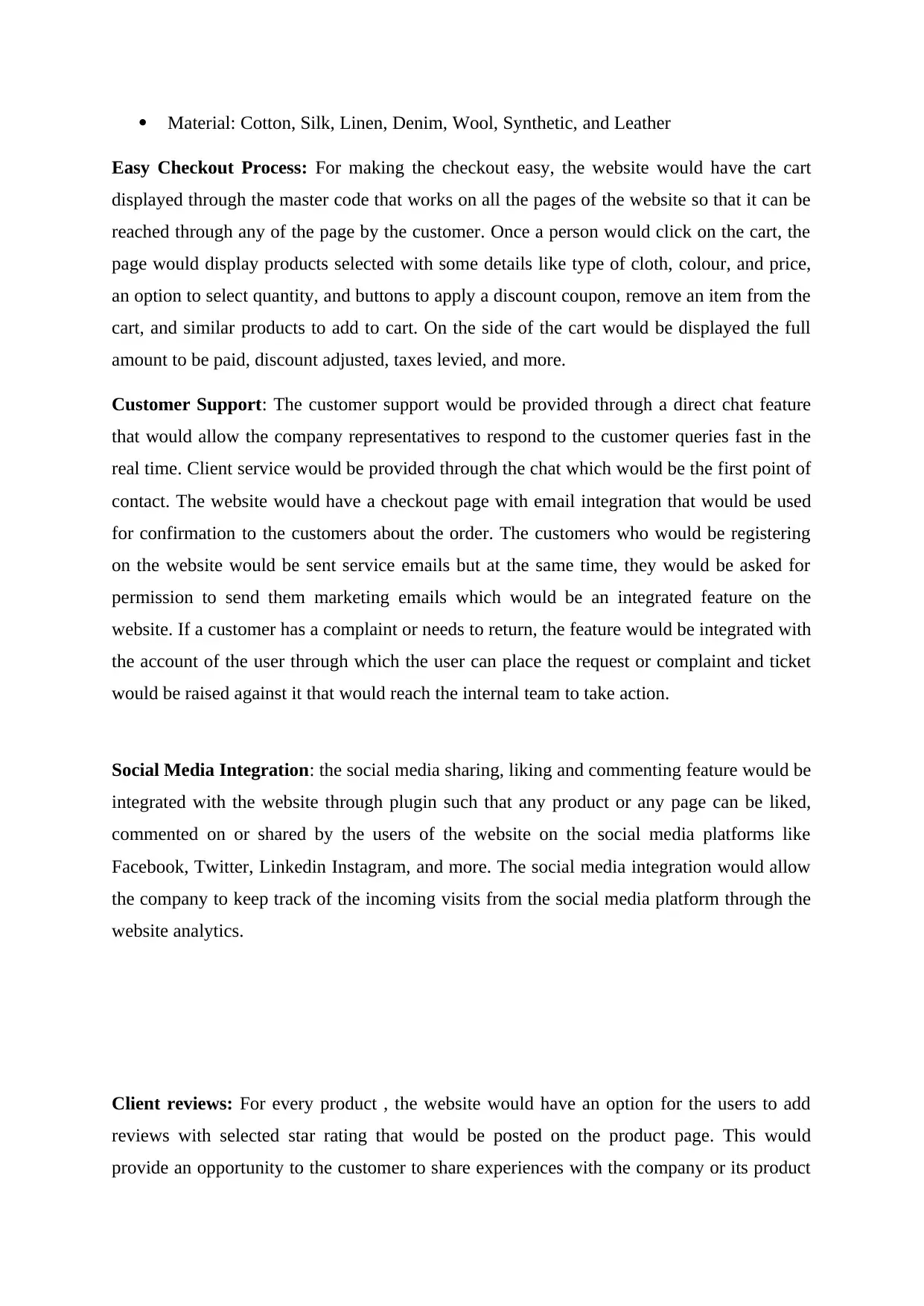
Material: Cotton, Silk, Linen, Denim, Wool, Synthetic, and Leather
Easy Checkout Process: For making the checkout easy, the website would have the cart
displayed through the master code that works on all the pages of the website so that it can be
reached through any of the page by the customer. Once a person would click on the cart, the
page would display products selected with some details like type of cloth, colour, and price,
an option to select quantity, and buttons to apply a discount coupon, remove an item from the
cart, and similar products to add to cart. On the side of the cart would be displayed the full
amount to be paid, discount adjusted, taxes levied, and more.
Customer Support: The customer support would be provided through a direct chat feature
that would allow the company representatives to respond to the customer queries fast in the
real time. Client service would be provided through the chat which would be the first point of
contact. The website would have a checkout page with email integration that would be used
for confirmation to the customers about the order. The customers who would be registering
on the website would be sent service emails but at the same time, they would be asked for
permission to send them marketing emails which would be an integrated feature on the
website. If a customer has a complaint or needs to return, the feature would be integrated with
the account of the user through which the user can place the request or complaint and ticket
would be raised against it that would reach the internal team to take action.
Social Media Integration: the social media sharing, liking and commenting feature would be
integrated with the website through plugin such that any product or any page can be liked,
commented on or shared by the users of the website on the social media platforms like
Facebook, Twitter, Linkedin Instagram, and more. The social media integration would allow
the company to keep track of the incoming visits from the social media platform through the
website analytics.
Client reviews: For every product , the website would have an option for the users to add
reviews with selected star rating that would be posted on the product page. This would
provide an opportunity to the customer to share experiences with the company or its product
Easy Checkout Process: For making the checkout easy, the website would have the cart
displayed through the master code that works on all the pages of the website so that it can be
reached through any of the page by the customer. Once a person would click on the cart, the
page would display products selected with some details like type of cloth, colour, and price,
an option to select quantity, and buttons to apply a discount coupon, remove an item from the
cart, and similar products to add to cart. On the side of the cart would be displayed the full
amount to be paid, discount adjusted, taxes levied, and more.
Customer Support: The customer support would be provided through a direct chat feature
that would allow the company representatives to respond to the customer queries fast in the
real time. Client service would be provided through the chat which would be the first point of
contact. The website would have a checkout page with email integration that would be used
for confirmation to the customers about the order. The customers who would be registering
on the website would be sent service emails but at the same time, they would be asked for
permission to send them marketing emails which would be an integrated feature on the
website. If a customer has a complaint or needs to return, the feature would be integrated with
the account of the user through which the user can place the request or complaint and ticket
would be raised against it that would reach the internal team to take action.
Social Media Integration: the social media sharing, liking and commenting feature would be
integrated with the website through plugin such that any product or any page can be liked,
commented on or shared by the users of the website on the social media platforms like
Facebook, Twitter, Linkedin Instagram, and more. The social media integration would allow
the company to keep track of the incoming visits from the social media platform through the
website analytics.
Client reviews: For every product , the website would have an option for the users to add
reviews with selected star rating that would be posted on the product page. This would
provide an opportunity to the customer to share experiences with the company or its product
⊘ This is a preview!⊘
Do you want full access?
Subscribe today to unlock all pages.

Trusted by 1+ million students worldwide
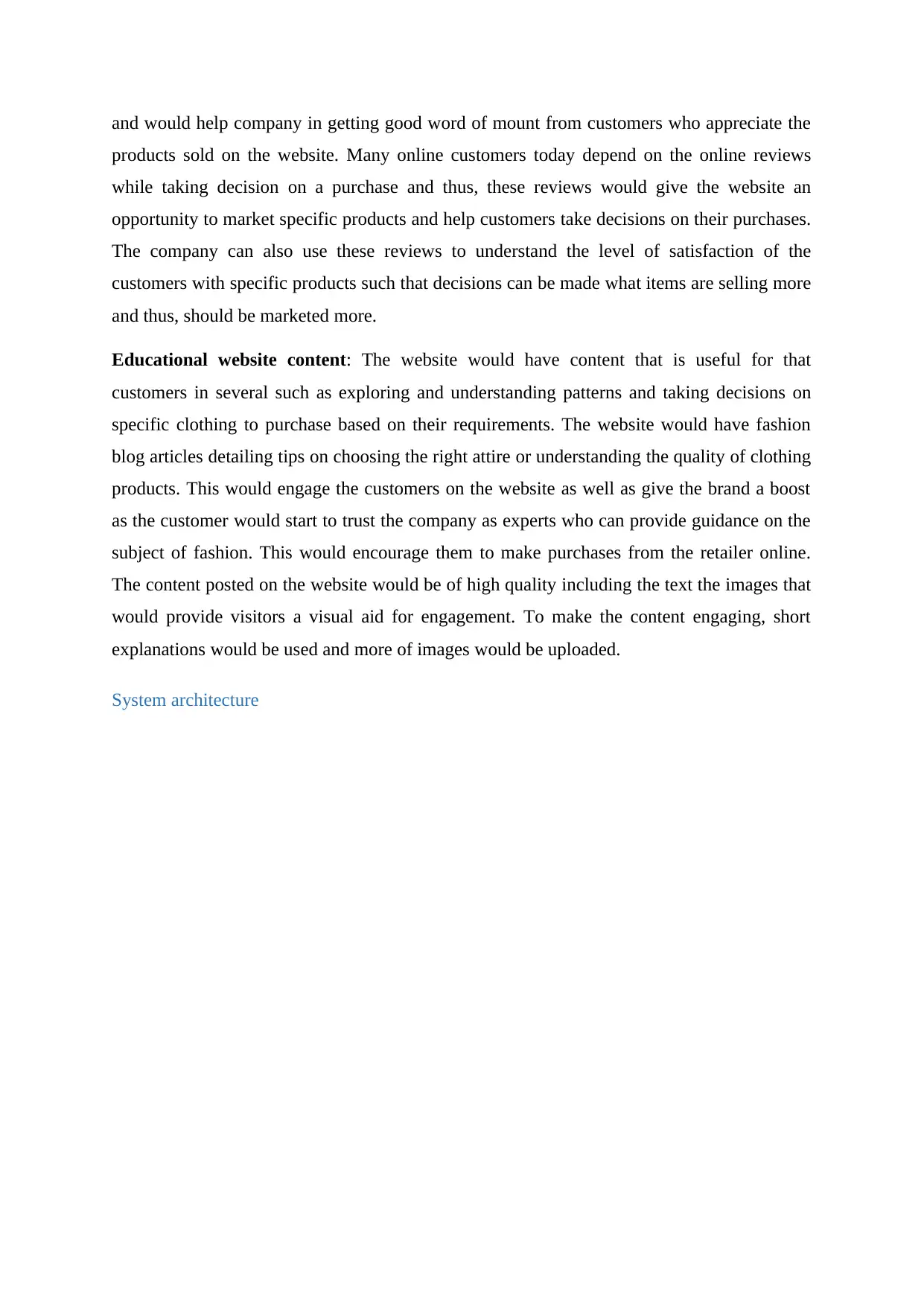
and would help company in getting good word of mount from customers who appreciate the
products sold on the website. Many online customers today depend on the online reviews
while taking decision on a purchase and thus, these reviews would give the website an
opportunity to market specific products and help customers take decisions on their purchases.
The company can also use these reviews to understand the level of satisfaction of the
customers with specific products such that decisions can be made what items are selling more
and thus, should be marketed more.
Educational website content: The website would have content that is useful for that
customers in several such as exploring and understanding patterns and taking decisions on
specific clothing to purchase based on their requirements. The website would have fashion
blog articles detailing tips on choosing the right attire or understanding the quality of clothing
products. This would engage the customers on the website as well as give the brand a boost
as the customer would start to trust the company as experts who can provide guidance on the
subject of fashion. This would encourage them to make purchases from the retailer online.
The content posted on the website would be of high quality including the text the images that
would provide visitors a visual aid for engagement. To make the content engaging, short
explanations would be used and more of images would be uploaded.
System architecture
products sold on the website. Many online customers today depend on the online reviews
while taking decision on a purchase and thus, these reviews would give the website an
opportunity to market specific products and help customers take decisions on their purchases.
The company can also use these reviews to understand the level of satisfaction of the
customers with specific products such that decisions can be made what items are selling more
and thus, should be marketed more.
Educational website content: The website would have content that is useful for that
customers in several such as exploring and understanding patterns and taking decisions on
specific clothing to purchase based on their requirements. The website would have fashion
blog articles detailing tips on choosing the right attire or understanding the quality of clothing
products. This would engage the customers on the website as well as give the brand a boost
as the customer would start to trust the company as experts who can provide guidance on the
subject of fashion. This would encourage them to make purchases from the retailer online.
The content posted on the website would be of high quality including the text the images that
would provide visitors a visual aid for engagement. To make the content engaging, short
explanations would be used and more of images would be uploaded.
System architecture
Paraphrase This Document
Need a fresh take? Get an instant paraphrase of this document with our AI Paraphraser
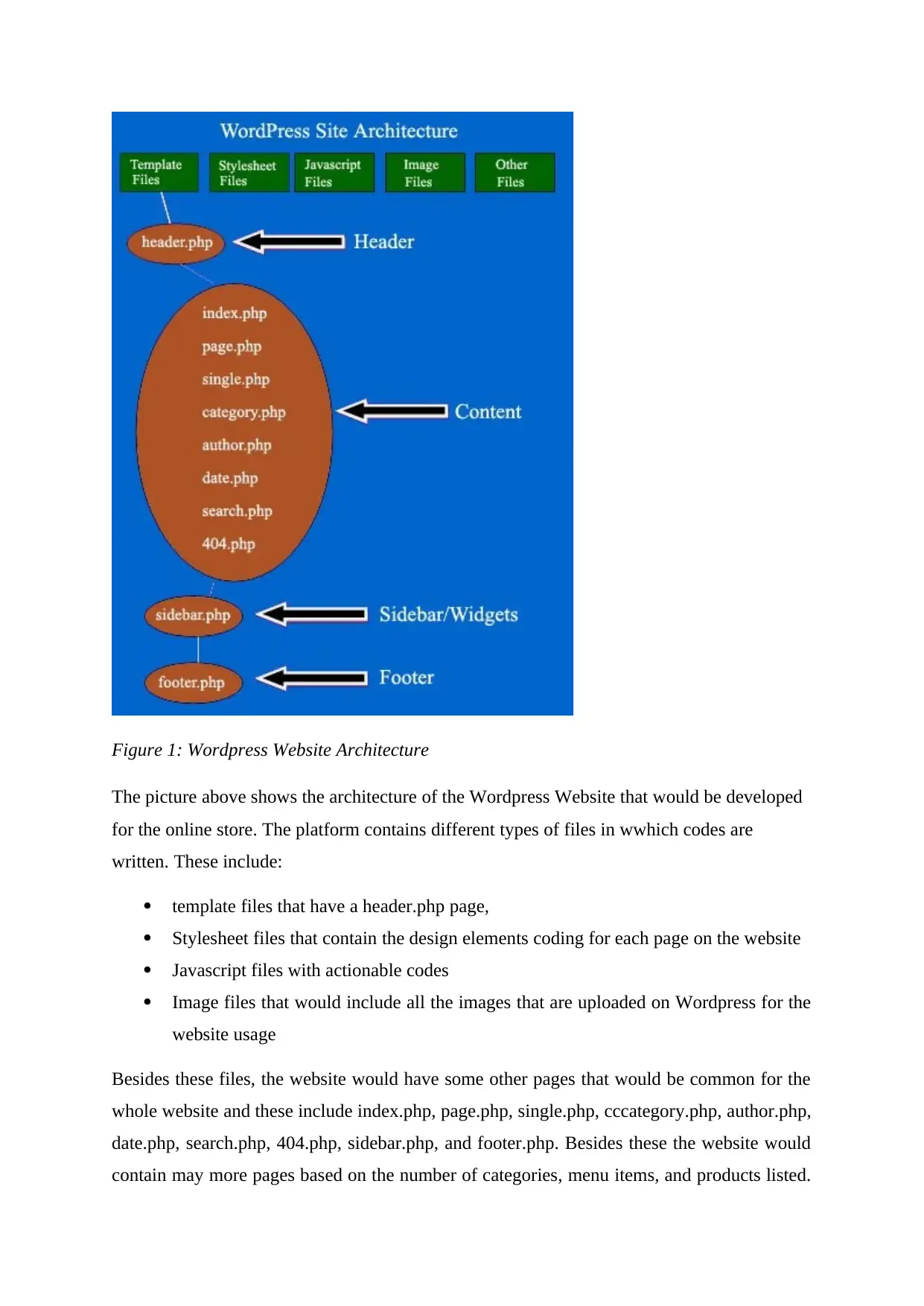
Figure 1: Wordpress Website Architecture
The picture above shows the architecture of the Wordpress Website that would be developed
for the online store. The platform contains different types of files in wwhich codes are
written. These include:
template files that have a header.php page,
Stylesheet files that contain the design elements coding for each page on the website
Javascript files with actionable codes
Image files that would include all the images that are uploaded on Wordpress for the
website usage
Besides these files, the website would have some other pages that would be common for the
whole website and these include index.php, page.php, single.php, cccategory.php, author.php,
date.php, search.php, 404.php, sidebar.php, and footer.php. Besides these the website would
contain may more pages based on the number of categories, menu items, and products listed.
The picture above shows the architecture of the Wordpress Website that would be developed
for the online store. The platform contains different types of files in wwhich codes are
written. These include:
template files that have a header.php page,
Stylesheet files that contain the design elements coding for each page on the website
Javascript files with actionable codes
Image files that would include all the images that are uploaded on Wordpress for the
website usage
Besides these files, the website would have some other pages that would be common for the
whole website and these include index.php, page.php, single.php, cccategory.php, author.php,
date.php, search.php, 404.php, sidebar.php, and footer.php. Besides these the website would
contain may more pages based on the number of categories, menu items, and products listed.
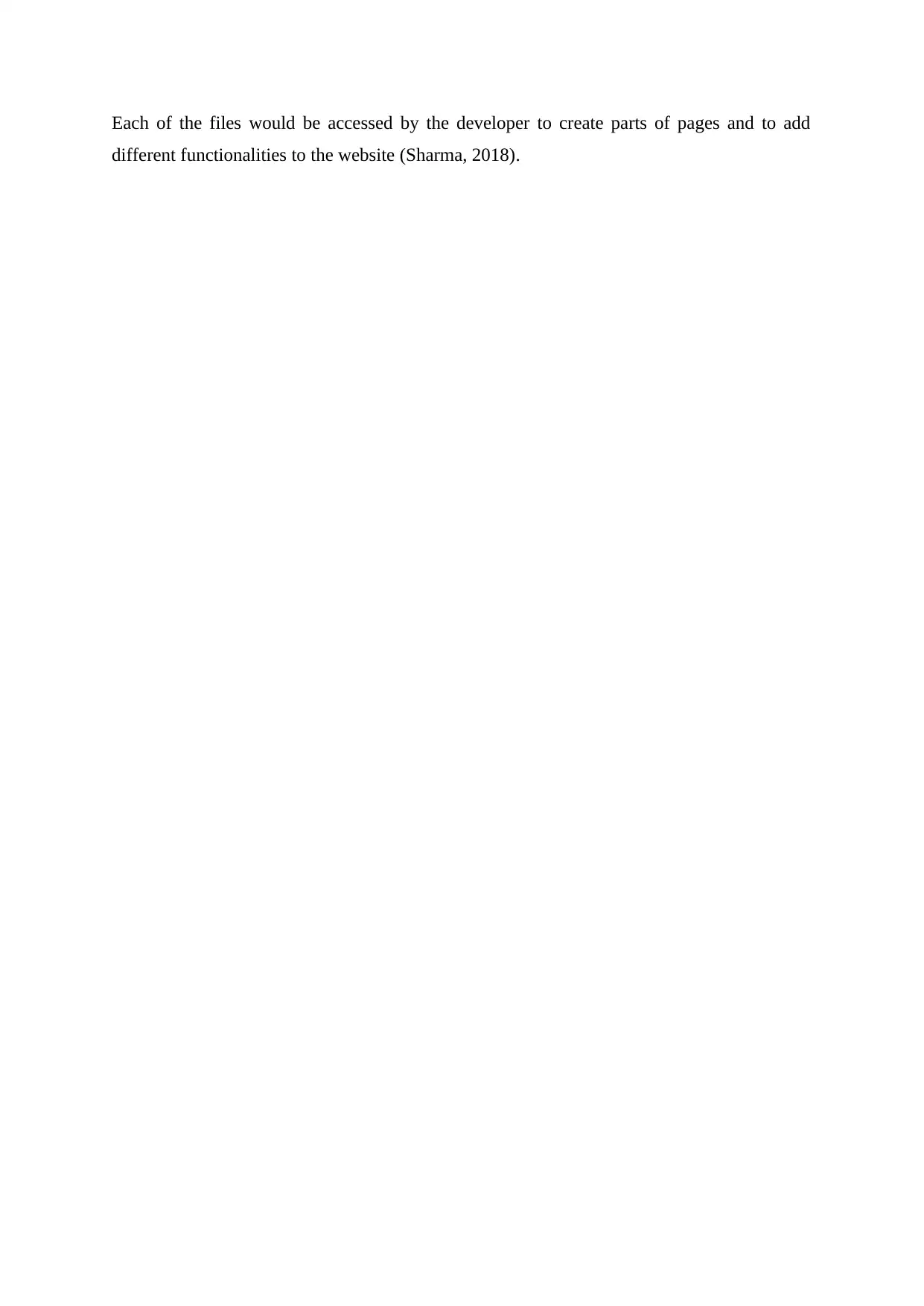
Each of the files would be accessed by the developer to create parts of pages and to add
different functionalities to the website (Sharma, 2018).
different functionalities to the website (Sharma, 2018).
⊘ This is a preview!⊘
Do you want full access?
Subscribe today to unlock all pages.

Trusted by 1+ million students worldwide
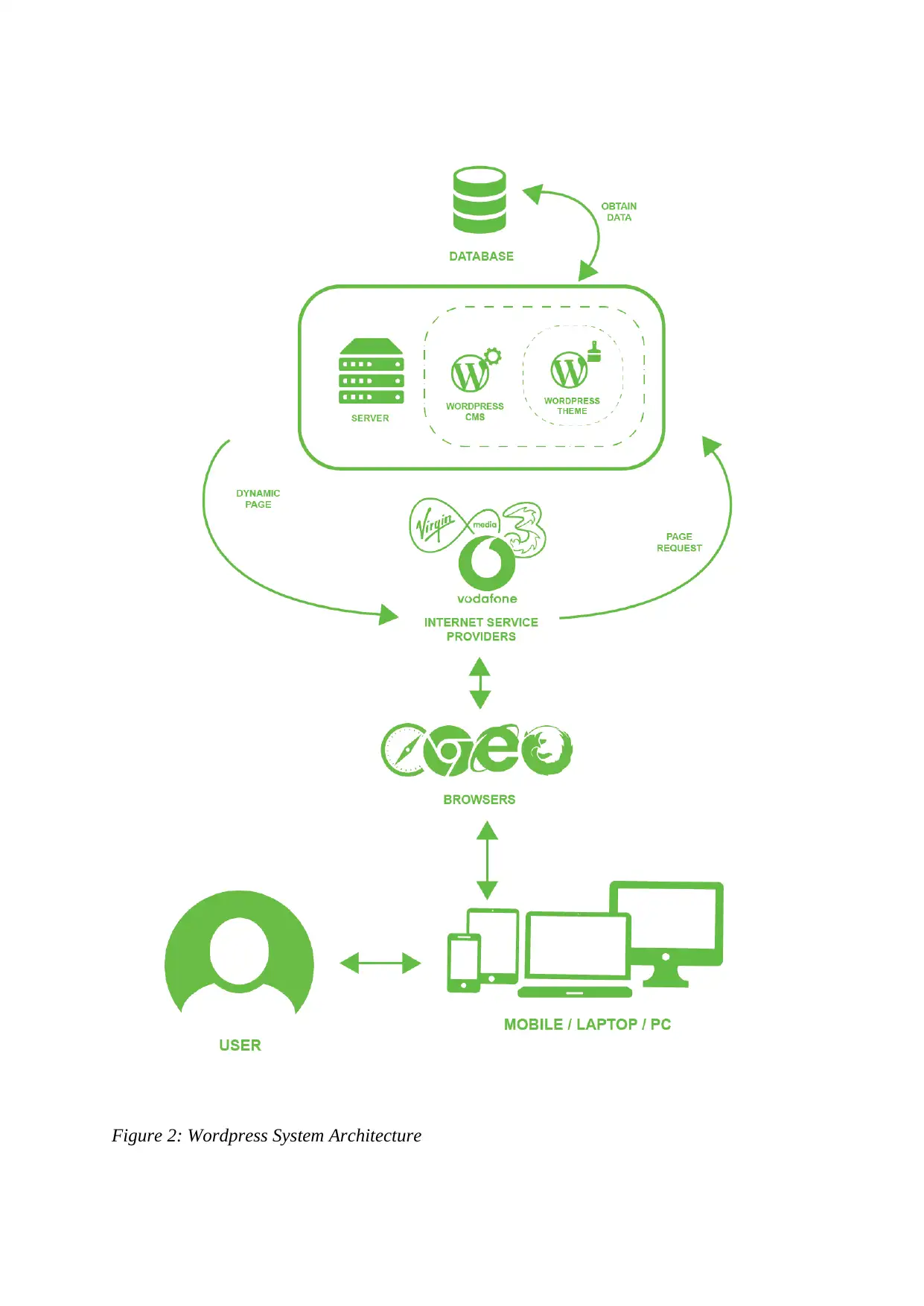
Figure 2: Wordpress System Architecture
Paraphrase This Document
Need a fresh take? Get an instant paraphrase of this document with our AI Paraphraser
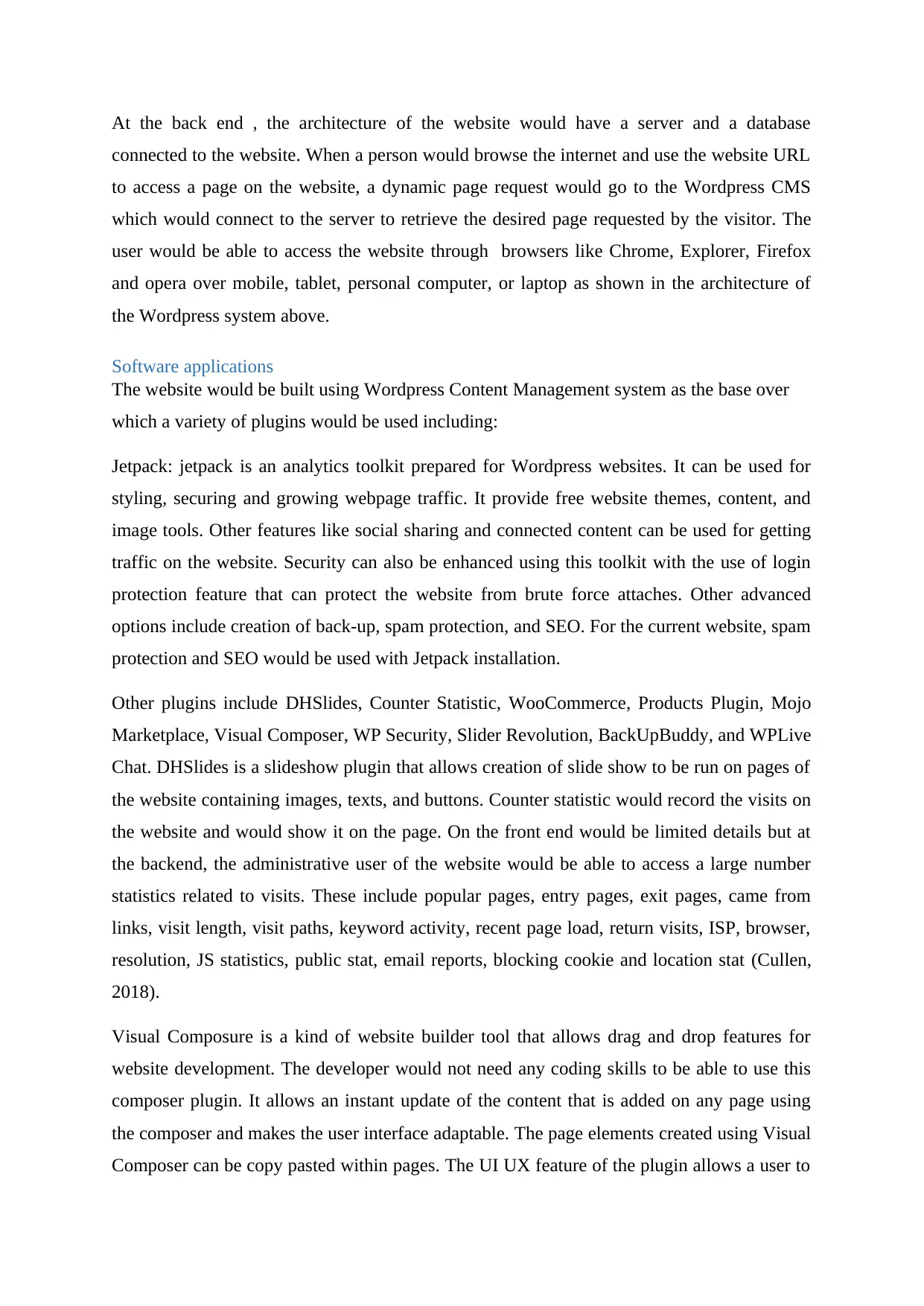
At the back end , the architecture of the website would have a server and a database
connected to the website. When a person would browse the internet and use the website URL
to access a page on the website, a dynamic page request would go to the Wordpress CMS
which would connect to the server to retrieve the desired page requested by the visitor. The
user would be able to access the website through browsers like Chrome, Explorer, Firefox
and opera over mobile, tablet, personal computer, or laptop as shown in the architecture of
the Wordpress system above.
Software applications
The website would be built using Wordpress Content Management system as the base over
which a variety of plugins would be used including:
Jetpack: jetpack is an analytics toolkit prepared for Wordpress websites. It can be used for
styling, securing and growing webpage traffic. It provide free website themes, content, and
image tools. Other features like social sharing and connected content can be used for getting
traffic on the website. Security can also be enhanced using this toolkit with the use of login
protection feature that can protect the website from brute force attaches. Other advanced
options include creation of back-up, spam protection, and SEO. For the current website, spam
protection and SEO would be used with Jetpack installation.
Other plugins include DHSlides, Counter Statistic, WooCommerce, Products Plugin, Mojo
Marketplace, Visual Composer, WP Security, Slider Revolution, BackUpBuddy, and WPLive
Chat. DHSlides is a slideshow plugin that allows creation of slide show to be run on pages of
the website containing images, texts, and buttons. Counter statistic would record the visits on
the website and would show it on the page. On the front end would be limited details but at
the backend, the administrative user of the website would be able to access a large number
statistics related to visits. These include popular pages, entry pages, exit pages, came from
links, visit length, visit paths, keyword activity, recent page load, return visits, ISP, browser,
resolution, JS statistics, public stat, email reports, blocking cookie and location stat (Cullen,
2018).
Visual Composure is a kind of website builder tool that allows drag and drop features for
website development. The developer would not need any coding skills to be able to use this
composer plugin. It allows an instant update of the content that is added on any page using
the composer and makes the user interface adaptable. The page elements created using Visual
Composer can be copy pasted within pages. The UI UX feature of the plugin allows a user to
connected to the website. When a person would browse the internet and use the website URL
to access a page on the website, a dynamic page request would go to the Wordpress CMS
which would connect to the server to retrieve the desired page requested by the visitor. The
user would be able to access the website through browsers like Chrome, Explorer, Firefox
and opera over mobile, tablet, personal computer, or laptop as shown in the architecture of
the Wordpress system above.
Software applications
The website would be built using Wordpress Content Management system as the base over
which a variety of plugins would be used including:
Jetpack: jetpack is an analytics toolkit prepared for Wordpress websites. It can be used for
styling, securing and growing webpage traffic. It provide free website themes, content, and
image tools. Other features like social sharing and connected content can be used for getting
traffic on the website. Security can also be enhanced using this toolkit with the use of login
protection feature that can protect the website from brute force attaches. Other advanced
options include creation of back-up, spam protection, and SEO. For the current website, spam
protection and SEO would be used with Jetpack installation.
Other plugins include DHSlides, Counter Statistic, WooCommerce, Products Plugin, Mojo
Marketplace, Visual Composer, WP Security, Slider Revolution, BackUpBuddy, and WPLive
Chat. DHSlides is a slideshow plugin that allows creation of slide show to be run on pages of
the website containing images, texts, and buttons. Counter statistic would record the visits on
the website and would show it on the page. On the front end would be limited details but at
the backend, the administrative user of the website would be able to access a large number
statistics related to visits. These include popular pages, entry pages, exit pages, came from
links, visit length, visit paths, keyword activity, recent page load, return visits, ISP, browser,
resolution, JS statistics, public stat, email reports, blocking cookie and location stat (Cullen,
2018).
Visual Composure is a kind of website builder tool that allows drag and drop features for
website development. The developer would not need any coding skills to be able to use this
composer plugin. It allows an instant update of the content that is added on any page using
the composer and makes the user interface adaptable. The page elements created using Visual
Composer can be copy pasted within pages. The UI UX feature of the plugin allows a user to
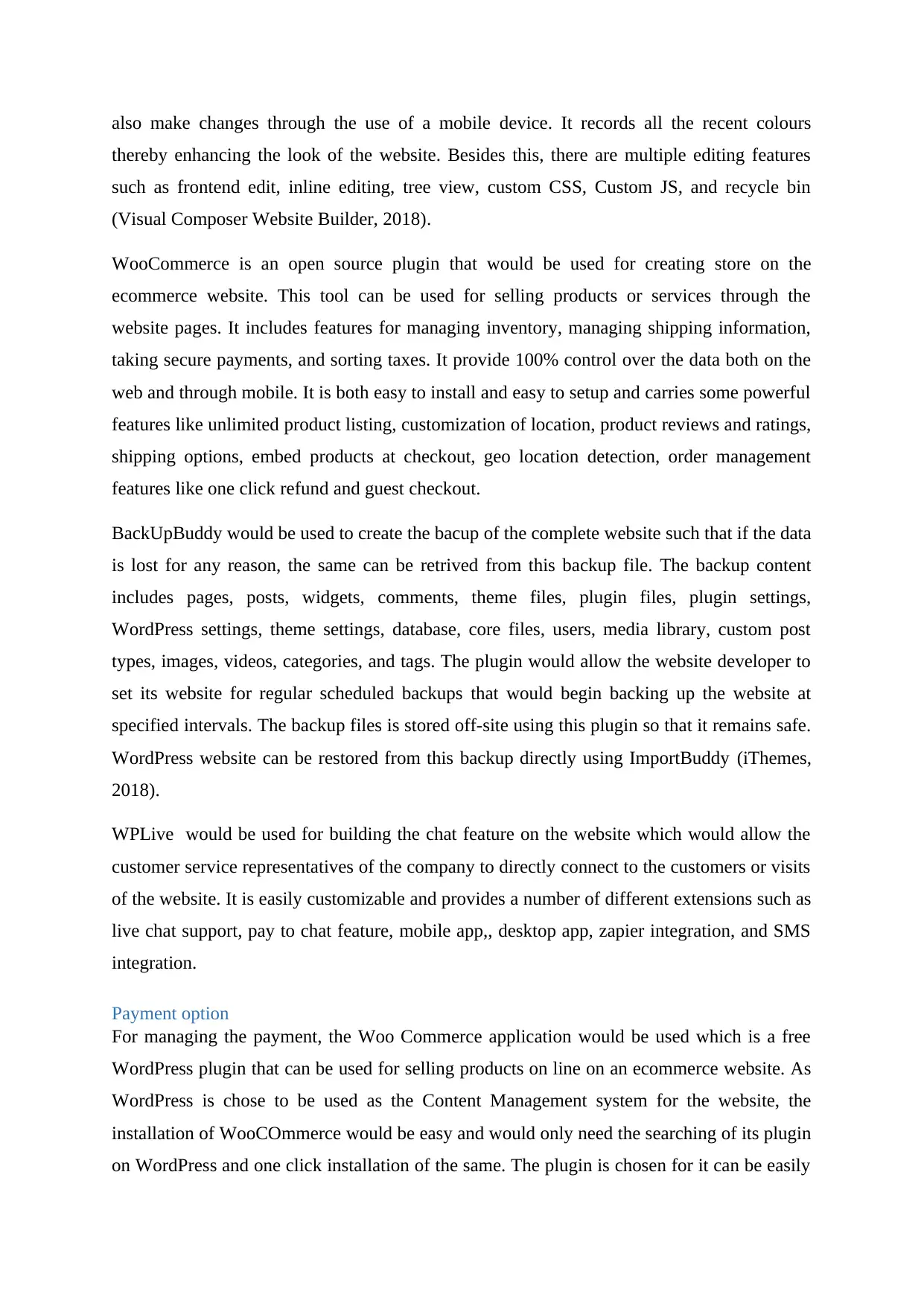
also make changes through the use of a mobile device. It records all the recent colours
thereby enhancing the look of the website. Besides this, there are multiple editing features
such as frontend edit, inline editing, tree view, custom CSS, Custom JS, and recycle bin
(Visual Composer Website Builder, 2018).
WooCommerce is an open source plugin that would be used for creating store on the
ecommerce website. This tool can be used for selling products or services through the
website pages. It includes features for managing inventory, managing shipping information,
taking secure payments, and sorting taxes. It provide 100% control over the data both on the
web and through mobile. It is both easy to install and easy to setup and carries some powerful
features like unlimited product listing, customization of location, product reviews and ratings,
shipping options, embed products at checkout, geo location detection, order management
features like one click refund and guest checkout.
BackUpBuddy would be used to create the bacup of the complete website such that if the data
is lost for any reason, the same can be retrived from this backup file. The backup content
includes pages, posts, widgets, comments, theme files, plugin files, plugin settings,
WordPress settings, theme settings, database, core files, users, media library, custom post
types, images, videos, categories, and tags. The plugin would allow the website developer to
set its website for regular scheduled backups that would begin backing up the website at
specified intervals. The backup files is stored off-site using this plugin so that it remains safe.
WordPress website can be restored from this backup directly using ImportBuddy (iThemes,
2018).
WPLive would be used for building the chat feature on the website which would allow the
customer service representatives of the company to directly connect to the customers or visits
of the website. It is easily customizable and provides a number of different extensions such as
live chat support, pay to chat feature, mobile app,, desktop app, zapier integration, and SMS
integration.
Payment option
For managing the payment, the Woo Commerce application would be used which is a free
WordPress plugin that can be used for selling products on line on an ecommerce website. As
WordPress is chose to be used as the Content Management system for the website, the
installation of WooCOmmerce would be easy and would only need the searching of its plugin
on WordPress and one click installation of the same. The plugin is chosen for it can be easily
thereby enhancing the look of the website. Besides this, there are multiple editing features
such as frontend edit, inline editing, tree view, custom CSS, Custom JS, and recycle bin
(Visual Composer Website Builder, 2018).
WooCommerce is an open source plugin that would be used for creating store on the
ecommerce website. This tool can be used for selling products or services through the
website pages. It includes features for managing inventory, managing shipping information,
taking secure payments, and sorting taxes. It provide 100% control over the data both on the
web and through mobile. It is both easy to install and easy to setup and carries some powerful
features like unlimited product listing, customization of location, product reviews and ratings,
shipping options, embed products at checkout, geo location detection, order management
features like one click refund and guest checkout.
BackUpBuddy would be used to create the bacup of the complete website such that if the data
is lost for any reason, the same can be retrived from this backup file. The backup content
includes pages, posts, widgets, comments, theme files, plugin files, plugin settings,
WordPress settings, theme settings, database, core files, users, media library, custom post
types, images, videos, categories, and tags. The plugin would allow the website developer to
set its website for regular scheduled backups that would begin backing up the website at
specified intervals. The backup files is stored off-site using this plugin so that it remains safe.
WordPress website can be restored from this backup directly using ImportBuddy (iThemes,
2018).
WPLive would be used for building the chat feature on the website which would allow the
customer service representatives of the company to directly connect to the customers or visits
of the website. It is easily customizable and provides a number of different extensions such as
live chat support, pay to chat feature, mobile app,, desktop app, zapier integration, and SMS
integration.
Payment option
For managing the payment, the Woo Commerce application would be used which is a free
WordPress plugin that can be used for selling products on line on an ecommerce website. As
WordPress is chose to be used as the Content Management system for the website, the
installation of WooCOmmerce would be easy and would only need the searching of its plugin
on WordPress and one click installation of the same. The plugin is chosen for it can be easily
⊘ This is a preview!⊘
Do you want full access?
Subscribe today to unlock all pages.

Trusted by 1+ million students worldwide
1 out of 18
Related Documents
Your All-in-One AI-Powered Toolkit for Academic Success.
+13062052269
info@desklib.com
Available 24*7 on WhatsApp / Email
![[object Object]](/_next/static/media/star-bottom.7253800d.svg)
Unlock your academic potential
Copyright © 2020–2025 A2Z Services. All Rights Reserved. Developed and managed by ZUCOL.





